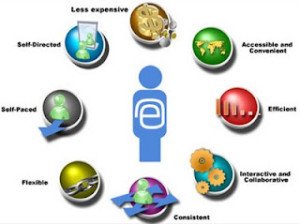How Effective is eLearning?
ELearning is a relatively new educational tool. Although the first computer assisted instruction has been around since the 1960s it has been over the 10 years that eLearning content and service providers have been gearing up for the expected k-12 conversion to primarily eLearning instruction. As stated in a recent report by State Educational Technology Directors Association (SETDA) paper textbooks will be out of the U.S. classroom in 5 to 7 years. Yet because of the relative newness of the phenomenon there is not a lot of research that has taken place on the effectiveness of eLearning instruction.
textbooks will be out of the U.S. classroom in 5 to 7 years. Yet because of the relative newness of the phenomenon there is not a lot of research that has taken place on the effectiveness of eLearning instruction.
Most of us have been reading stuff on our PC monitors for about 25 years long before the Kindle and iPad. But with the advent of the various mobile devices the convenience of obtaining instant information has outweighed the discomfort. Most adult readers would rather curl up with a good paper book than a stiff laptop. There are several new apps out which enrich the reading experience on an eBook.
In a 2008 study, graduate students at the University of Toronto’s ISchool focusing on student experience with electronic textbooks which explores studies of how electronic textbooks impact different levels of education. “Electronic textbooks are widely accepted by young students. Young student with different learning abilities have different needs as do the different genders. Young students in the UK, between the ages of 11 and 16, showed significant differences in students’ performances and behaviors for students using electronic text and print. Students using the electronic textbooks scored higher in both group tests and individual test and were more willing to participate in group activities, whereas students using printed textbooks were less involved and less well behaved. The authors of the study said that young students using electronic textbooks had a higher desire to learn, increased their learning capacity and became more self-motivated suggesting that the medium itself may have a positive effect. Young students seem to be more receptive to new technologies and different ways to learn. They are more eager to use new tools and are easily encouraged by interactive media. Using electronic textbooks in the classroom can promote an active learning approach which improves both the motivation and quality of learning. “
 In another study of 15 and 16-year olds in Estonia, “the findings clearly indicate which features and characteristics encourage or discourage students of different achievement levels and in each gender. They suggest that providing clear instructions and examples, familiar icons and commands, using keyboard as the data-entry method, and using dark text on light background will better support the low-achieving students. In contrast, high-achieving students will benefit from more complex levels of navigation, use of analogies and fewer terms in the contents of the materials. This study also indicates that the density of information design and complexity of navigational design can have a negative impact on girls’ learning. In other words, the different characteristics of an electronic textbook have a direct influence on how students with different learning abilities interact with each text and therefore affect how students learn. Matching the characteristics of an electronic text to the learning abilities of the students who will use it can enable students to learn more effectively.”
In another study of 15 and 16-year olds in Estonia, “the findings clearly indicate which features and characteristics encourage or discourage students of different achievement levels and in each gender. They suggest that providing clear instructions and examples, familiar icons and commands, using keyboard as the data-entry method, and using dark text on light background will better support the low-achieving students. In contrast, high-achieving students will benefit from more complex levels of navigation, use of analogies and fewer terms in the contents of the materials. This study also indicates that the density of information design and complexity of navigational design can have a negative impact on girls’ learning. In other words, the different characteristics of an electronic textbook have a direct influence on how students with different learning abilities interact with each text and therefore affect how students learn. Matching the characteristics of an electronic text to the learning abilities of the students who will use it can enable students to learn more effectively.”
In three studies of college students from computer science and psychology, the finding showed that “student’s views of the use of electronic textbooks were either neutral or unfavorable.” This indicated that adjusting to new methods of study by older students is problematic when compared to k-12 students.
“A successful electronic textbook should empower students and facilitate their learning – it should be an effective learning tool. The key areas to consider in such a tool include student’s learning style, ability, and behavior as well as a balance of design features and usability.”
style, ability, and behavior as well as a balance of design features and usability.”
“Young students using electronic textbooks can benefit from the active learning approach, which traditional print books may not offer. Youths have better understanding, remember more, and learn more about the subject when using electronic textbooks. Designers of electronic textbooks for youth should focus on features that increase students’ intercreativity, collaboration, and interaction.”
“Learning ability has a direct influence on how effectively one can access reading materials. Because students have different learning abilities, educational software should be designed to meet specific needs. For instance, both keyboard and mouse are recommended for low-achieving students. When acquiring knowledge, high-achieving students prefer analogies, whereas low-achieving students benefit from using examples. Low achieving students often need more help in order to excel in school. The development of electronic textbooks to address low-achieving students’ needs will not only help them to access the text itself, but more importantly, it will empower them to acquire knowledge and build their self-confidence. Understanding students’ learning ability, teachers can choose the electronic text to match with students’ needs.” Open Education Resource options are a good way to facilitate these choices.
“Learning behavior changes when one accesses text in electronic format. Students are accustomed to scan through a text to get an overview of the material. This, however, becomes difficult while using an electronic version. Instead of scanning through the text, students may skim it. When reading electronic text, students prefer to start from the table of contents to determine which chapters seem relevant. Highlighting, underlining, and note taking, activities that are considered to support active reading are not equally represented in digital form. These findings suggest that designers of electronic textbooks should consider how students would use them differently from print. Directly mimicking a print version may lead to problems in accessing the materials. A well-designed electronic text should minimize the users’ learning curve. To replicate a more natural style in digital form, methods such as touch-screen and electronic-pen are worth exploring.”
 “Traditional textbooks do not always cover all the materials that are required in a course curriculum. Instead, electronic textbooks can be easily updated with new materials and tailored to meet the need of a specific course. Electronic textbooks should utilize the digital features to add value that supports course requirements and different learning activities. Interactive features such as shared annotations, shared bookmarks, or multi-highlighting can facilitate active and collaborative learning, but they need to be both useful and usable for students and teachers. Navigation was identified as one of the main usability issues which need to be addressed in many studies.”
“Traditional textbooks do not always cover all the materials that are required in a course curriculum. Instead, electronic textbooks can be easily updated with new materials and tailored to meet the need of a specific course. Electronic textbooks should utilize the digital features to add value that supports course requirements and different learning activities. Interactive features such as shared annotations, shared bookmarks, or multi-highlighting can facilitate active and collaborative learning, but they need to be both useful and usable for students and teachers. Navigation was identified as one of the main usability issues which need to be addressed in many studies.”
The conclusion of this study stated that “Since reading from print books is deeply rooted in our culture electronic textbooks should be seen as an extension of print books and not a replacement but an enhancement. Switching from print to electronic format requires a learning curve for adult learners, whereas young learners find it a lot easier to adjust. Designing electronic textbooks for youths may have greater potential for success. The shortcoming of this essay is that it had to be based on the very limited number of studies available and the outcomes of each study cannot be generalized; they represent a unique setting of each case. They also illustrate the reaction from a cross section of different levels of education and a wide range of disciplines. It seems that many disciplines do have an interest in using electronic textbooks; however, students are generally not ready for it.”
There are several new apps out which enrich the reading experience on an eBook and make reading from an eBook more like reading from a paper book. Amazon’s Kindle has a free app that works great for reading and syncs with eBooks you may already have bought. Apple’s free “iBooks” is also a good e-reader app, with more stylish graphics.

Recent Comments